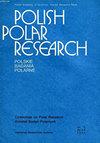Deglaciation rate on southern and western Spitsbergen in the conditions of Arctic amplification
IF 0.8
4区 地球科学
Q4 ECOLOGY
引用次数: 9
Abstract
This paper reports on a morphometric analysis of land-terminating glaciers on southern and western Spitsbergen in the years 1936–2014. An attempt was made to estimate the deglaciation rate and the scale of its acceleration in the 21st century in the conditions of Arctic amplification. Satellite scenes and topographic map sheets were used for the study and were analyzed by means of remote sensing and GIS methods. The study covered 2000–2014 years and concluded that surface recession accelerated on average by a factor of 2.75 compared to the 1936–2000 period, while linear recession was 2.2 times faster. The greatest increase in the deglaciation rate can be observed in the case of glaciers faced to N and W sectors. The deglaciation process is the most advanced in the central part of the island, where small, compact mountain glaciers predominate. In recent years, a slowdown in the deglaciation processes in these glaciers was observed. The studies demonstrate that the deglaciation rate was mainly influenced by the basin relief determining the glacier geometry. The resultant fractal nature of the ice cover makes it highly vulnerable to the disintegration of complex glacial systems into smaller ones due to glacier thinning and the separation of outlets. The acceleration of the deglaciation rate in turn is modified by the climate factor, especially the impact of warming air masses from the N and W sectors where seas are becoming increasingly ice-free and, consequently, have an increasing heat capacity.北极放大条件下斯匹次卑尔根岛南部和西部的消冰速率
本文报道了1936年至2014年斯匹次卑尔根半岛南部和西部陆地末端冰川的形态计量学分析。在北极放大条件下,对21世纪的冰川消融速率及其加速规模进行了估算。利用卫星场景和地形图进行研究,并通过遥感和GIS方法进行分析。该研究涵盖了2000年至2014年,得出的结论是,与1936年至2000年期间相比,地表衰退的平均速度加快了2.75倍,而线性衰退的速度加快了2.2倍。在面向北、西两扇区的冰川中,消冰速率的增加幅度最大。消冰作用在岛中部最为严重,那里主要是小而致密的山地冰川。近年来,观测到这些冰川的消冰过程有所减缓。研究表明,消冰速率主要受盆地起伏决定冰川几何形状的影响。由于冰川变薄和出水口分离,冰盖的分形特性使其极易受到复杂冰川系统分解成较小冰川系统的影响。冰川消融速度的加速反过来又受到气候因素的影响,特别是来自北半球和西半球的变暖气团的影响,这些地区的海洋正变得越来越无冰,因此热容量也在增加。
本文章由计算机程序翻译,如有差异,请以英文原文为准。
求助全文
约1分钟内获得全文
求助全文
来源期刊

Polish Polar Research
ECOLOGY-GEOSCIENCES, MULTIDISCIPLINARY
CiteScore
2.00
自引率
7.70%
发文量
0
审稿时长
>12 weeks
期刊介绍:
The quarterly Polish Polar Research edited by the Committee on Polar Research of the Polish Academy of Sciences is an international journal publishing original research articles presenting the results of studies carried out in polar regions.
All papers are peer-reviewed and published in English.
The Editorial Advisory Board includes renowned scientist from Poland and from abroad.
 求助内容:
求助内容: 应助结果提醒方式:
应助结果提醒方式:


